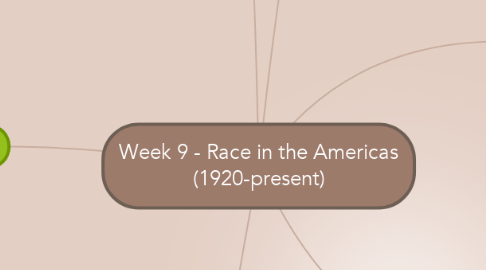
1. Brazil & the Democracy Myth
1.1. UNESCO-sponsored research developed a new racial revisionism because in addition to having "significant limitations" the main culprit was the "tendency to reduce race to class", also known as reductionism.
1.2. The impact of the reappearance of a black movement brought 2 perspectives.
1.2.1. #1) The Revisionist perspective which had to do with racial conflict diminishing as Brazil became more of a capitalist society.
1.2.2. #2) The Structuralist perspective which meant that "smooth maintenance: would come under a military dictatorship.
1.3. The impact of the reappearance of black democratization in Brazil
1.3.1. It was the abertura, a painfully slow re-emergence of civil society, which created the conditions under which black political opposition could reappear.
1.4. Argument for Racial Formation Theory
1.4.1. What it is?
1.4.1.1. Originally developed as a response to reductionism. It is a perspective that understands race as a phenomenon whose meaning is contested throughout social life.
1.4.2. My thoughts?
1.4.2.1. I think that change is tough for anyone, no matter the color of your skin. I think that what I have seen is history consistently repeating itself and harming those that are entitled to basic human rights, but instead someone decides that other people don't matter. This was a situation that should not have been ignored to begin with, it is silly to think that a situation such as one like this can fix itself.
2. Indigenous Communities
2.1. Guarani
2.1.1. Are partial to Brazil, Paraguay, Bolivia, Uruguay, and Argentina
2.1.1.1. Ranchers are taking the land of the Guarani people and killing them in the process.
2.1.1.2. The Guarani see "Land as an origin of life".
2.2. Mapuche
2.2.1. Primarily based in Chile
2.2.1.1. Land has been seized from the Mapuche and sold, primarily, to paper companies.
2.2.1.2. Mapuche are not an aggressive community, they are peaceful, but they do actively protest the injustices done to their people.
2.2.1.3. Their cities are being militarized/invaded.
3. Zapatistas (EZLN)
3.1. The Zapatista Movement began after the election fraud in Mexico took place in 1988.
3.1.1. EZLN declared war on January 1st, 1994.
3.1.2. They gave the Mexican government 34 demands, prior to ending the war.
3.2. Originated from a revolutionary fighter named Emiliano Zapata
3.3. Zapatistas started in Chiapas, Mexico in the 1900s
4. Asian Immigration to Latin America
4.1. Asian Immigration to Latin America started in the 1500s
4.1.1. Most Japanese immigrants were in Brazil
4.1.2. Most Chinese immigrants were in Mexico
4.2. Tepito, Mexico
4.2.1. Neighborhood is amongst the poorest in Mexico City.
4.2.2. Cocaine is sold openly in this neighborhood
4.3. Spain established the Manila galleon trade, which lasted some three centuries, linking China and Japan via the Philippines.
4.4. From 1847-1874 there were 250K Chinese coolies under an 8 yr. contract that were sent to Cuba and Peru- specifically they were sent to plantations.
5. Afro-Mexicans
5.1. Blacks suffered the same discrimination that they dealt with here in the US. The handling was slightly different, but the premise was the same. They were considered a sub-par species of people.
5.2. From 1519-1810- Spanish brought over 250K enslaved Africans to Mexico.
5.3. Contemporary Afro-Mexicans identified with themselves as Mexican and not black.
6. Cultural Fusion in Columbia
6.1. Change came to Columbia with the development of black organizations
6.1.1. the Center for the Investigation and Development of Black Culture
6.1.2. Cimarron
